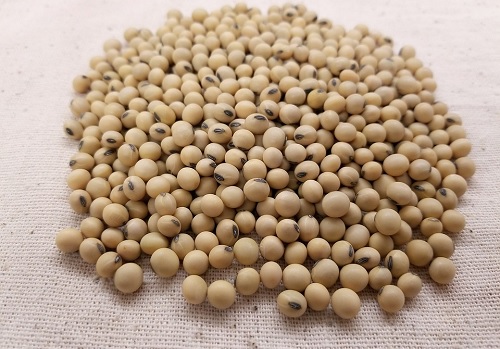Jeera trading range for the day is 27460-30800 - Kedia Advisory

Gold
Gold prices experienced a marginal decline of -0.1%, settling at 63257, driven by the dollar index's 0.8% rise to 102.1. Traders are actively evaluating the economic and monetary policy outlook, with a likelihood of a Fed rate cut in March exceeding 80%. Investors are eagerly awaiting the FOMC minutes and the upcoming jobs report for additional insights into the Fed's future actions and the overall performance of the US economy. Rate-cut expectations are fueled by notable progress in underlying inflation, approaching the 2% target, and easing labor market conditions attributed to a restrictive monetary policy stance. Fed Chair Jerome Powell underscored the Fed's primary objective of achieving price stability. According to the CME FedWatch tool, there is a 72% chance of a 25 basis points interest rate cut to 5.00-5.25% in March, with a similar probability for continued reductions in May. The Eurozone Manufacturing PMI increased slightly to 44.4 in December, exceeding preliminary estimates of 44.2. Some sub-indices indicated improvement, with reductions in new orders and purchasing activity easing, and business confidence reaching an eight-month high. In November, China's net gold imports via Hong Kong rose by approximately 37%, reaching 36.801 metric tons compared to 26.793 tons in October. Technically, the market is under long liquidation, witnessing a drop in open interest by -1.72%. Gold finds support at 63025, and a break below could test 62790. Resistance is anticipated at 63575, with a move above potentially leading to testing 63890.
Trading Ideas:
* Gold trading range for the day is 62790-63890.
* Gold falls as dollar strengthens amid economic and policy evaluations.
* Factors that are boosting rate-cut hopes are significant progress in the underlying inflation declining towards 2%.
* There is a 72% chance that the Fed will reduce interest rates by 25 basis points (bps) to 5.00-5.25%.
Silver
Silver prices experienced a slight decline of -0.4%, settling at 74095, as investors eagerly await upcoming US jobs data this week to gain insights into potential moves by the Federal Reserve. Tensions escalated in the Middle East after US helicopters repelled an attack by Iran-backed Houthi militants on a Maersk container vessel in the Red Sea, a crucial trade route between Europe and Asia. This geopolitical development adds an element of uncertainty to the market, contributing to potential volatility. Investors should brace for a volatile week, with various economic reports scheduled for release. China's factory activity expanded at a quicker pace in December, driven by stronger gains in output and new orders, according to a private-sector survey. However, business confidence for 2024 remained subdued. The Caixin/S&P Global manufacturing PMI rose to 50.8 at the end of 2023, marking the fastest expansion in seven months and surpassing forecasts. Contrastingly, Asia's factory activity weakened in December, signaling a shaky start for the region's manufacturing powerhouses in 2024. China's uneven economic recovery hampered a broader revival in demand. The upcoming release of ADP's private payrolls report on Wednesday and December's jobs report on Friday may provide further evidence supporting expectations of a Federal Reserve interest rate cut this year. Technically, the silver market is under fresh selling pressure, witnessing a gain in open interest by 4.09%. Silver finds support at 73760, and a break below could test 73420. Resistance is likely at 74720, with a move above potentially leading to testing 75340.
Trading Ideas:
* Silver trading range for the day is 73420-75340.
* Silver falls ahead of US jobs data, investors watch Federal Reserve.
* Middle East tensions escalated after U.S. helicopters repelled an attack by Iran-backed Houthi militants in the Red Sea.
* Investors should brace for volatility this week as various economic reports are lined for release.
Crude oil
Crude oil prices faced a decline of -1.39%, settling at 5943, as the United States reached a record high in crude production, estimated at 13.3 million barrels per day. This surge in crude output, up by 200,000 barrels per day from the previous week, added pressure to oil prices. Concerns about increasing global crude supplies and slowing demand growth also contributed to the downward pressure. The U.S. achieving a record high in crude production, along with simultaneous record outputs in Brazil and Guyana, raised apprehensions about oversupply in the oil market. Additionally, geopolitical events, such as Angola's unexpected exit from OPEC, vessel attacks by Houthi rebels disrupting trade in the Red Sea, and the potential for prolonged conflict in Gaza, added uncertainties to the market. In October, U.S. crude oil shipments via rail rose by 17,000 barrels per day from the previous month, reaching 226,000 barrels per day, as reported by the U.S. Energy Information Administration. Despite the challenges, money managers increased their net long U.S. crude futures and options positions in the week ending December 26, according to the U.S. Commodity Futures Trading Commission (CFTC). The speculator group raised its combined futures and options position in New York and London by 15,954 contracts to 84,266 during this period. Technically, the crude oil market is currently under fresh selling pressure, with a gain in open interest by 9.74%. Support is identified at 5834, and a breach below this level could test 5724. On the upside, resistance is likely at 6101, and a move above may lead to testing 6258.
Trading Ideas:
* Crudeoil trading range for the day is 5724-6258.
* Crude oil prices drop as US hits record high in production
* Concerns about increasing global supplies and slowing demand growth
* US crude oil shipments via rail increase in October
Natural gas
Natural gas prices experienced a decline of -0.65%, settling at 212.5, driven by record-high domestic natural gas production in the United States. Robust production levels allowed utilities to build reserves, resulting in inventories that are currently 10% above the seasonal average. Despite this, the downside is limited due to increased seasonal demand, especially with anticipated cold weather in January. The surge in exports further supported natural gas prices, as gas flows to liquefied natural gas (LNG) export facilities reached an all-time high in December. This export demand adds a positive factor to the market, potentially balancing the impact of high domestic production. Looking ahead, the weather forecast indicates a decrease in temperatures in London, with an amber weather warning issued due to Storm Henk, bringing heavy rain and strong winds. While this may drive up seasonal demand, subdued industrial consumption and ample renewable generation could limit significant fuel cost hikes. Data from LSEG revealed that average gas output in the Lower 48 U.S. states has increased to 103.5 billion cubic feet per day (bcfd) in 2023 from a record 98.4 bcfd in 2022. The U.S. entered the winter heating season with the most natural gas in storage since 2020, according to the U.S. Energy Information Administration (EIA). Technically, the natural gas market is under fresh selling pressure, with a gain in open interest by 11.23%. Support is identified at 207.2, and a breach below this level could test 201.8. On the upside, resistance is likely at 220.6, and a move above could see prices testing 228.6.
Trading Ideas:
* Naturalgas trading range for the day is 201.8-228.6.
* Natural gas prices fall due to high production and increased reserves
* Surge in natural gas exports, reaching all-time high in December.
* Record-high domestic natural gas production in the US leads to higher reserves.
Copper
Copper prices experienced a decline of -0.17%, settling at 729.85, primarily influenced by a stronger dollar. The rebound in the U.S. dollar, as traders assessed the potential for Federal Reserve loosening in the coming year, contributed to the pressure on copper prices. A stronger dollar lifts the currency used to price copper benchmarks, reducing the purchasing power of importers and, consequently, lowering copper prices. Despite the overall decline, copper inventories in Shanghai's monitored warehouses saw a significant reduction, dropping nearly 90% to 30,905 tons since late February. Similarly, in bonded warehouses in Shanghai, copper stocks fell by 96% to 6,500 tons since mid-March. The drawdown in inventories typically suggests robust demand or supply chain constraints, supporting the market to some extent. However, doubts about demand prospects are evident in the discount for cash copper over the three-month contract, which is trading near 31-year lows. Concerns about demand were fueled by a sharp decline in the official Chinese manufacturing Purchasing Managers' Index (PMI), despite improved expansion according to broader Caixin data. Traders should closely monitor developments in the U.S. dollar, Chinese economic indicators, and global demand trends for copper. Technically, the market is under fresh selling pressure, with support identified at 727.2. A breach below this level could test 724.6, while resistance is likely at 733.3, with a move above potentially leading to testing 736.8.
Trading Ideas:
* Copper trading range for the day is 724.6-736.8.
* Copper prices eased due to a stronger dollar, but losses were limited.
* Copper inventories in Shanghai warehouses dropped nearly 90% since late February.
* Doubts about demand prospects reflected in low cash copper prices.
Zinc
Zinc prices registered a decline of -1.12%, settling at 230.55, influenced by factors such as China's official Purchasing Managers' Index (PMI) falling to 49 in December from the previous month, indicating the need for potential stimulus measures from the Chinese government. However, the Caixin/S&P Global manufacturing PMI rose to 50.8, surpassing market forecasts and suggesting a slight recovery. The industrial outlook for zinc improved with hopes of early interest rate cuts by major central banks and the anticipation of a fuller economic recovery in China, a top consumer of zinc. The global zinc market deficit eased to 52,500 metric tons in October from a deficit of 62,000 tons in September, according to the International Lead and Zinc Study Group (ILZSG). However, data for the first 10 months of 2023 showed a surplus of 295,000 tons compared to a deficit of 33,000 tons in the same period in 2022. Zinc inventories in Shanghai Futures Exchange-monitored warehouses recorded a notable decline of -16.60% from the previous Friday. Additionally, in November 2023, China's refined zinc output was 579,000 metric tons, representing a month-on-month decrease of 4.23% but a year-on-year increase of 10.62%. From a technical perspective, the market is currently experiencing long liquidation, with a drop in open interest by -13.85%. Support for zinc is identified at 228.6, and a breach below this level could test 226.7. On the upside, resistance is likely at 232.8, and a move above this could lead to testing 235.1.
Trading Ideas:
* Zinc trading range for the day is 226.7-235.1.
* Zinc prices dropped as China's official PMI fell to 49 in December.
* Global zinc market deficit eased to 52,500 metric tons in October.
* Year-on-year increase of 10.62% in China's refined zinc output.
Aluminium
Aluminium prices experienced a decline of -1.82%, settling at 208.25, primarily influenced by a notable increase in stocks in LME-approved warehouses, rising by 28% to 566,375 tons since December 6. This surge in inventory has impacted market sentiment, particularly for a metal widely used in the power, construction, and packaging industries. Despite this, the downside appears limited as aluminium found support due to concerns about the supply of feedstock alumina. A blast in Guinea last month damaged fuel stocks at the main terminal, affecting the supply of alumina, a critical raw material derived from bauxite. The Caixin China General Manufacturing PMI for December 2023 inched up to 50.8, surpassing market forecasts and indicating the highest reading since August. Output experienced the most substantial growth in seven months, and new orders rose at the fastest pace since February. However, new export orders fell at the softest pace in six months. Official data revealed a further contraction in Chinese manufacturing activity in December, while a private survey suggested an unexpected acceleration in the country's manufacturing sector growth. This has led to speculations that the People’s Bank of China might ease policy further in 2024 to support the economic recovery. From a technical standpoint, the market is undergoing long liquidation, with a drop in open interest by -7.99%. Aluminium is finding support at 206.4, and a breach below this level could test 204.3. On the upside, resistance is likely at 212, and a move above could lead to testing 215.5.
Trading Ideas:
* Aluminium trading range for the day is 204.3-215.5.
* Aluminium prices dropped due to increased stocks in LME-approved warehouses.
* Chinese manufacturing activity contracted in December, but private survey showed unexpected growth.
* Expectations of further policy easing by the People's Bank of China.
Cotton
Cotton prices, represented by Cottoncandy, experienced a marginal decline of -0.04%, settling at 56160, driven by profit booking following earlier gains. The Cotton Association of India (CAI) maintained its pressing estimate for the 2023-24 season at 294.10 lakh bales, contributing to market sentiment. Total supply till the end of November was estimated at 92.05 lakh bales, consisting of market arrivals, imports, and opening stocks. Reports of a decline in pink bollworm infestation in the cotton crop brought relief, decreasing from 30.62% in 2017-18 to 10.80% in 2022-23. Infestation was observed across cotton-growing areas in the north, central, and south zones of the country. Certified cotton stocks for delivery against contracts dropped significantly, reaching 6,325 bales on December 5th from their highest level in over two years at 87,770 bales on December 1st. Brazilian cotton shipments increased by 12% in November compared to October 2023 but decreased by 5.5% compared to November 2022. The International Cotton Advisory Committee (ICAC) projected that global cotton production would surpass consumption for the second consecutive year. Global cotton lint production is expected to grow by 3.25% to 25.4 million metric tons in the 2023-24 season, while consumption is forecasted to marginally decline to 23.4 million metric tons. In Rajkot, a major spot market, Cottoncandy prices ended at 26429.95 Rupees, reflecting a decline of -0.27%. Technically, the market observed long liquidation, with no change in open interest, settling at 209. Cottoncandy is currently finding support at 56020, and a breach below could test 55870 levels. Resistance is anticipated at 56300, and a move above could lead to a test of 56430.
Trading Ideas:
* Cottoncandy trading range for the day is 55870-56430.
* Cotton dropped on profit booking after prices gained as Cotton output may decline by 8%
* Total supply till end November was estimated at 92.05 lakh bales, which consisted market arrivals of 60.15 lakh bales
* ICAC projected that global cotton production will likely outpace consumption for the second year in a row.
* In Rajkot, a major spot market, the price ended at 26429.95 Rupees dropped by -0.27 percent.
Turmeric
Turmeric prices inched up by 0.13% to settle at 14114, primarily due to concerns over potential yield losses caused by unfavorable weather conditions. However, the upside is limited as buying activities have been slow, with expectations of stock releases ahead of the commencement of new crops in January 2024. Pressure on prices is also attributed to improved crop conditions resulting from favorable weather. Support for the market is derived from anticipated export opportunities. The Turmeric Board in Telangana initiated by Prime Minister Modi has sparked concerns among farmers in Maharashtra over the headquarters location, creating a certain level of uncertainty. Despite this, the crop condition is reported to be satisfactory, and harvest is expected during January to March. Current levels of buying activity and decreasing supplies are expected to sustain price stability. The demand for turmeric has improved both in developed and emerging nations, leading to a 25% increase in exports. Turmeric exports during Apr-Oct 2023 rose by 2.63% to 1,02,162.94 tonnes compared to 99,585.88 tonnes in the same period of 2022. In October 2023, exports increased by 11.58% compared to September 2023 but declined by 9.30% compared to October 2022. Technically, the market observed short-covering, with a -0.4% drop in open interest, settling at 12415. Turmeric is currently finding support at 13946, and a breach below could test 13780 levels. Resistance is expected at 14232, and a move above could lead to a test of 14352.
Trading Ideas:
* Turmeric trading range for the day is 13780-14352.
* Turmeric benefits from potential yield losses caused by unfavorable weather.
* However, upside seen limited as buying activities has been slower
* Turmeric exports during Apr-Oct 2023, rose by 2.63 percent at 1,02,162.94 tonnes as compared to Apr-Oct 2022.
* In Nizamabad, a major spot market, the price ended at 13300.7 Rupees dropped by -0.09 percent.
Jeera
Jeera prices recorded a notable rebound, rising by 0.92% and settling at 29530, driven by low-level recovery after a previous drop attributed to higher production prospects in Gujarat and Rajasthan. The aggressive sowing for Jeera in Gujarat and reports of sluggish exports are expected to exert pressure on prices in the near term. Favorable weather conditions have facilitated smooth sowing activities, resulting in a substantial increase in the sown area for Jeera in Gujarat, reaching nearly 102% with 544,099.00 hectares compared to the area in 2022 at 268,775.00 hectares as of 26-12-2023. Rajasthan has also witnessed a 13% increase in the area under cumin cultivation. The global demand for Indian Jeera has declined as buyers prefer alternative origins like Syria and Turkey due to the comparatively higher prices in India. Export prospects for Jeera are expected to remain subdued in the upcoming months, aligning with seasonal patterns. Jeera exports during Apr-Oct 2023 contracted by 34.02%, amounting to 76,367.90 tonnes compared to 115,748.90 tonnes in the same period of 2022. In October 2023, exports dropped by 13.39% compared to September 2023 and by 46.77% compared to October 2022. In the Unjha spot market, Jeera prices ended at 33356.15 Rupees, reflecting a decline of -0.84%. Technically, the market witnessed fresh buying, with a 3.84% increase in open interest, settling at 2433. Jeera is currently finding support at 28500, and a breach below could test 27460 levels. Resistance is anticipated at 30170, and a move above could lead to a test of 30800.
Trading Ideas:
* Jeera trading range for the day is 27460-30800.
* Jeera gains on on low level recovery after prices dropped due to higher production prospects
* In Gujarat, Cumin sowing witnessed very strong growth by nearly 103% with 530,030.00 hectares against sown area of 2022
* Stockists are showing interest in buying on recent downfall in prices triggering short covering.
* In Unjha, a major spot market, the price ended at 33356.15 Rupees dropped by -0.84 percent.
Views express by all participants are for information & academic purpose only. Kindly read disclaimer before referring below views. Click Here For Disclaimer






















